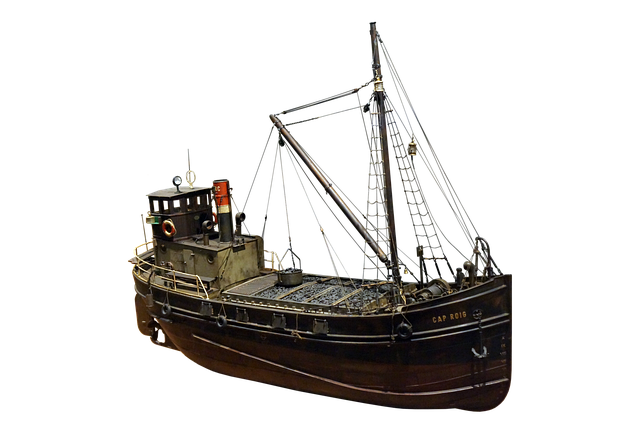Optimizing Your Boat’s Power: A Guide to Selecting the Ideal Battery Size
When selecting a boat battery, it's crucial to consider your vessel's electrical demands, including devices like navigation systems, fish finders, lighting, and other electronics. You need to choose a battery with an appropriate ampere-hour (Ah) capacity and the right type—lead-acid…….

When selecting a boat battery, it's crucial to consider your vessel's electrical demands, including devices like navigation systems, fish finders, lighting, and other electronics. You need to choose a battery with an appropriate ampere-hour (Ah) capacity and the right type—lead-acid, AGM (Absorbent Glass Mat), or lithium—based on factors such as weight, maintenance requirements, and budget. AGM batteries offer a balance between performance and portability without acid leakage risks, while lithium batteries are lighter and provide higher power output but come with a higher upfront cost. Battery size should be tailored to your boat's age, the final state of charge at trip end, and depth of discharge (DoD) during use. Proper battery sizing ensures reliable power for both short and long voyages. Adhering to the manufacturer's guidelines for your specific boat model is essential for optimal performance and compatibility. Understanding the distinctions between deep-cycle and starter batteries, as well as the different battery technologies like AGM and lithium-ion, will help you make an informed decision. These considerations ensure that your chosen battery provides consistent power output, longevity, and suits the nature of your maritime activities. Regular maintenance, compatible chargers, and understanding how to operate the battery effectively are key for sustained power and extended battery life. By carefully evaluating these factors, you can select a boat battery that offers dependable service throughout multiple boating seasons.
When venturing out on the water, selecting the appropriate boat battery is a critical decision that impacts both your journey’s safety and its enjoyment. With diverse marine battery technologies and capacities available, understanding the right size and type for your vessel’s needs is essential. This article will guide you through three pivotal tips for choosing a boat battery that suits your power requirements, delves into the factors influencing battery size selection, explores the roles of deep-cycle versus starter batteries in marine applications, and navigates the latest in marine battery technologies, including AGM and Lithium-Ion options. Additionally, we’ll discuss maintenance and lifespan considerations to ensure your boat’s power source delivers optimal performance throughout your nautical adventures.
- Understanding Boat Battery Requirements: What Size You Need for Your Vessel
- Factors Influencing Boat Battery Size Selection: Ampere-Hours, Power Ratings, and Reserve Capacity
- The Role of Deep-Cycle vs. Starter Batteries in Marine Applications
- Navigating Marine Battery Technologies: AGM, Lithium-Ion, and Other Options
- Maintenance and Lifespan Considerations for Optimal Boat Battery Performance
Understanding Boat Battery Requirements: What Size You Need for Your Vessel

When selecting a boat battery, it’s crucial to consider the power requirements of your vessel and the nature of your boating activities. Boat batteries are not one-size-fits-all; their capacity must align with the electrical demands of your boat. Start by assessing the total power consumption on your boat, including navigation systems, fish finders, lighting, and any other electronic devices you plan to use. This will give you a baseline of how much ampere-hour (Ah) capacity you’ll need. Deep cycle marine batteries are typically the best choice for boats due to their ability to undergo multiple discharge-recharge cycles without compromising performance.
Next, consider the type of boat battery that suits your needs: lead-acid, AGM (Absorbent Glass Mat), or lithium. Lead-acid batteries have a long history of reliability but are generally heavier and require more maintenance. AGM batteries offer a balance between performance and weight without the risk of spilling acid. Lithium batteries are lighter and can provide more power, but they come with a higher initial cost. The size of the battery should also account for factors like battery age, state of charge at the end of a trip, and the depth of discharge (DoD) during usage. Properly sizing your boat battery ensures that you have a reliable power source, whether you’re on a leisurely cruise or an extended fishing expedition. Always refer to the manufacturer’s recommendations for your specific boat model to ensure compatibility and optimal performance.
Factors Influencing Boat Battery Size Selection: Ampere-Hours, Power Ratings, and Reserve Capacity

When selecting a battery for your marine vessel, it’s crucial to consider several key factors to ensure optimal performance and reliability on the water. Ampere-hours (Ah), power ratings, and reserve capacity are essential metrics that influence boat battery size selection. Ampere-hours denote the amount of energy a battery can deliver over a specific period, typically at a particular rate. For instance, a 100 Ah battery can theoretically supply 1 ampere for 100 hours or 5 amperes for 20 hours. This measurement is vital for determining how long your boat’s electrical systems will operate before requiring a recharge, especially on extended trips or during prolonged use of electronic devices like fish finders and GPS systems.
In addition to ampere-hours, power ratings—often expressed in watts or cranking amperes (CA) for starting applications—are another critical aspect to consider. Power ratings determine the battery’s ability to deliver high currents for short durations, which is necessary for engine starting. Boat batteries are designed with a balance between cranking power and deep-cycle capability to accommodate both starting the engine and powering electronics throughout your journey. Reserve capacity, denoted in minutes, measures how long a fully charged battery can maintain a steady output of 25 amperes at 80 degrees Fahrenheit before running down to 10.5 volts per cell (for lead-acid batteries). This is particularly important for safety and reliability when you’re far from shore, as it gives an indication of the battery’s endurance during heavy loads or in adverse conditions. By carefully assessing these factors, boat owners can choose a battery size that aligns with their vessel’s specific needs and ensures a safe and enjoyable boating experience.
The Role of Deep-Cycle vs. Starter Batteries in Marine Applications

When selecting the appropriate boat battery for your marine application, understanding the differences between deep-cycle and starter batteries is crucial. Starter batteries, similar to those found in automobiles, are designed for short, high-current bursts to crank an engine. These batteries, often lead-acid or lithium-ion types, can provide the necessary power to start your boat’s engine but are not suitable for deep discharge cycles that are typical in marine environments. On the other hand, deep-cycle batteries are purpose-built for repeated discharges and recharges, making them ideal for marine applications where they might be used for trolling, running electrical accessories, or as part of a house bank.
Deep-cycle batteries come in various types, including lead-acid (flooded, AGM, and gel) and lithium options. Each has its own advantages in terms of longevity, weight, lifecycle, and performance under different conditions. For instance, lithium deep-cycle batteries are lighter and offer more cycles than their lead-acid counterparts, which is a significant advantage when out on the water where weight savings can greatly impact a boat’s performance. Additionally, they have a higher energy density and are less sensitive to temperature changes, ensuring consistent power output regardless of environmental conditions. When selecting a deep-cycle battery for your marine needs, consider factors such as the size of your vessel, the duration and type of activities you’ll be engaging in, and the battery’s capacity to handle those demands over the long term. Properly maintaining and matching your boat battery with the correct charger and usage patterns will ensure a reliable power source for all your nautical adventures.
Navigating Marine Battery Technologies: AGM, Lithium-Ion, and Other Options

When selecting the optimal battery size for your marine vessel, it’s crucial to consider the types of marine battery technologies available, such as Absorbent Glass Mat (AGM), Lithium-Ion, and other options. Each technology offers distinct advantages that can impact your boat’s performance and reliability on the water. AGM batteries are a popular choice among boat owners due to their robust construction, which makes them resistant to vibrations and shocks typically encountered in maritime environments. They also have a high tolerance for extreme temperatures, ensuring consistent operation regardless of the weather conditions. Additionally, AGM batteries provide a reliable deep-cycle capability, making them ideal for the frequent discharge and recharge cycles associated with marine applications.
Lithium-Ion batteries represent the cutting edge in marine battery technology. They boast an impressive energy-to-weight ratio, offering more power without the additional bulk of traditional lead-acid batteries. This lightweight design can be a significant advantage when every pound counts on your boat. Lithium-Ion batteries also have a longer lifespan and maintain a charge better over time compared to other types. Their ability to handle numerous charge/discharge cycles without degradation makes them a smart investment for boat owners who prioritize longevity and efficiency. When choosing between AGM and Lithium-Ion, consider factors such as your vessel’s size, the nature of your marine activities, and your power requirements. Boat battery selection is a critical decision that can enhance your boating experience significantly. It’s essential to weigh the pros and cons of each type to ensure you have a reliable source of power for all your on-board needs.
Maintenance and Lifespan Considerations for Optimal Boat Battery Performance

When selecting the appropriate battery size for your vessel, it’s crucial to consider the maintenance and lifespan aspects that contribute to optimal performance. Boat batteries, particularly those used for deep-cycle applications, are designed to withstand frequent discharging and recharging cycles typical of marine use. To ensure your investment endures, regular maintenance is key. This includes keeping terminals clean, ensuring connections are secure, and monitoring battery levels during extended periods of non-use to prevent sulfation, which can reduce capacity and shorten lifespan.
The lifespan of a boat battery is influenced by several factors, including the type of battery technology you choose—lead-acid, AGM (Absorbent Glass Mat), or lithium-ion—as well as how it’s used. For instance, AGM and lithium-ion batteries generally offer longer service life and are less sensitive to temperature fluctuations compared to traditional lead-acid varieties. Regular charging with a compatible marine charger that matches the battery’s specifications is also vital for prolonging its lifespan. By understanding these considerations, you can select a battery that not only meets your power needs but also provides reliable service over many seasons on the water.
Selecting the optimal boat battery is a critical decision that ensures your nautical adventures are both safe and enjoyable. This article has outlined three pivotal tips for choosing the right battery size, focusing on understanding your vessel’s requirements, considering factors like ampere-hours and power ratings, and exploring the distinct roles of deep-cycle and starter batteries within marine settings. Additionally, we delved into the various marine battery technologies available, including AGM and lithium-ion options, and addressed maintenance and lifespan considerations to optimize performance. By keeping these guidelines in mind, you can confidently pick a boat battery that suits your needs and enhances your time on the water. Remember, the right battery size is a combination of capacity, technology, and understanding your boat’s power demands—choose wisely for a seamless journey.







